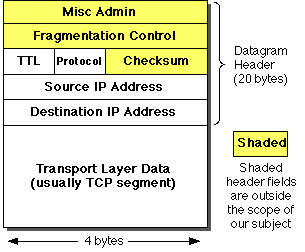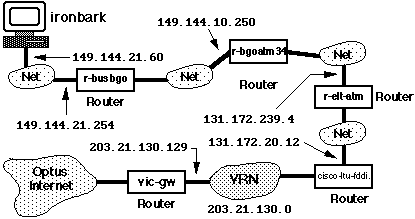Lecture 12: IP Networks
IP Datagrams
IP transmits data in packets called
datagrams. A datagram contains a header and
some data, thus:

Note: this diagram shows
the datagram format of the "current" version of IP, IPv4. The functions of the
yellow-shaded header fields are outside the scope of this subject -- see Data
Communications if interested.
Datagram Details
- The datagram header contains both the source and destination IP addresses
as well as various other administrative data. This means that every datagram
can be identified, in terms of "where it came from" and "where it's going".
- The TTL (Time to Live, or "hop count") field sets a
maximum number of routers which this datagram may traverse before it's assumed
to be "looping" and is discarded.
- Virtually all "real world" datagrams have a minimal length (20 byte)
header. Although various optional (extra) header fields are permitted, these
are rarely observed in the Real World™.
- Each network in the Internet is characterised by a Maximum
Transmission Unit (MTU), which defines the largest datagram which can
be sent on that network. Whilst the total length of a datagram can (in theory)
be up to 64 KB, "real world" MTU limits usually mean datagrams are < 1500
bytes in total length.
- The data field contains "higher layer" protocol data -- usually a TCP or
UDP segment which IP is delivering across the Internet. The
protocol field identifies which transport level protocol data
is being carried. We say that the TCP/UDP segment is
encapsulated in an IP datagram. The TCP/UDP segment, in turn,
usually contains application protocol data in its data field.
IP Routing
There are two levels of complexity involved in IP routing:
- Local delivery
- When the IP software is presented with a datagram for delivery, it first
checks the network/subnet part of the destination address to see if matches
its own network/subnet number -- the current netmask is used
to discover if these match. If the network/subnet part does match, then the
datagram can be delivered locally, and is simply handed to the physical
network delivery system (typically an Ethernet device driver) for
direct delivery over the local network.
- Internet delivery
- If the network numbers are different, then the datagram must be sent to a
directly-connected router (or IP gateway), using direct delivery as above, for
"on-delivery" across the Internet. Note that when the datagram is received at
the router, its destination IP address is not that of the router.
- Datagrams are forwarded from router to router across each of the
intervening networks until they reach a router connected to a network where
they can be locally delivered.
- The IP software in each router must keep a routing
table to know the IP address of an appropriate next-hop router
which brings the datagram closer to its destination.
- Note that routers must have (at least) two IP addresses, since they are
connected to (at least) two different networks/subnets!
IP Routing
Hosts and routers maintain a routing table
which is consulted when a datagram cannot be locally delivered. The routing
table indicates which router, of those available, is the best next
hop for the destination network address of this particular datagram.
For hosts, this is commonly done by configuring a default
route, since only one router is usually available.
Where the network is more complex (for example, a router can be connected to
several other routers) a routing protocol is used to maintain
the routing tables. Routing protocols operate by sending routing
updates to each of their neighbour routers, informing them of routes
which this router "knows about", and with some indication of how "close" it is
to the other networks -- this is called a metric. Route
information which has been received at a router will be propagated to the next
router, and so on. Routers make decisions as to which route is the one they will
use, based on the routing metric information.
Different routing protocols are used within Autonomous Systems
(AS) -- typically organisation-level networks -- and the various
high-speed intercontinental and international backbone networks
which make up the "heavy haulage" sections of the Internet. Within an AS, the
original routing protocol was RIP, nowadays largely replaced by
OSPF. On the backbones, the original protocol was
EGP, now replaced by BGP (strictly speaking,
BGP4).
Detailed analysis of routing protocol operation is outside the scope of this
subject, see Data
Communications and Internetworking.
IP: Connectionless Datagram Delivery
IP data transfer across an internet
is based on three fundamental principles:
- Unreliable delivery
- delivery of data is not guaranteed. A datagram may be lost (dropped,
discarded, etc) in the network, may be duplicated (ie: delivered twice) or may
be delivered out of order. The IP service will not detect such conditions, nor
will it notify the sender or receiver if they occur.
- Connectionless delivery
- each packet is treated entirely indpendently of all others. No information
is kept as to which packets have been forwarded, and packets may travel over
different routes to the same destination.
- Best-Effort delivery
- the packet delivery mechanism is engineered to always deliver packets if
possible. It will not gratuitously drop packets: unreliability should only
occur when underlying resources (eg buffer space) are exhausted.
These specifications allow the IP service to concentrate on its job:
delivering packets. As we have seen, higher level protocols (usually TCP)
transform the IP service into a reliable, sequenced interprocess communications
mechanism
The Structure of the Internet
The Internet consists of networks (or,
more commonly nowadays -- subnets) connected by routers. The
traceroute utility shows the path a datagram takes -- the following
traceroute is from ironbark to the Victorian Regional Network
(VRN).
1 r-busbgo.bendigo.latrobe.edu.au (149.144.21.254) 1 ms 2 ms 1 ms
2 r-bgoatm34.bendigo.latrobe.edu.au (149.144.10.250) 1 ms 1 ms 1 ms
3 r-sctech-atm.latrobe.edu.au (131.172.239.3) 5 ms 4 ms 3 ms
4 cisco-ltu-fddi.latrobe.edu.au (131.172.20.12) 5 ms 4 ms 4 ms
5 vic-gw.vrn.EDU.AU (203.21.130.129) 4 ms 5 ms 4 ms

Private IP Addresses/Networks
(This is Optional Material)
These are an interesting development in
Internetworking. IP addresses have recently become more difficult to obtain, and
therefore more expensive. Many organisations (and home users!) have moved to a
private address space for their "internal" networks -- ie,
networks consisting of machines which do not require globally-valid IP
addresses. This has advantages both in terms of cost and security (see later).
RFC1918 specifies a range of addresses: 10.0.0.0,
172.16.0.0 - 172.31.255.255 and 192.168.0.0 -
192.168.255.255 which can be used for this purpose. No IP addresses
in these three ranges are ever valid in the Internet (ie, an Internet router
should never forward them), and may only be used within private networks.
A variety of technologies are available to allow "internal" (private IP)
machines to gain access to services in the outside Internet. The two most common
are Network Address Translation (NAT) and
SOCKS. For "Web-only" access, an HTTP proxy server can be used.
The Future: IPv6
(This is Optional Material)
The current version of IP is widely
acknowledged to have many shortcomings. To address these, the Internet
Engineering Task Force (IETF) has defined IP version 6[1].
Some of its features include:
- Addresses are now 128 bits in total length, instead of 32 bits in IPv4.
This is a huge increase!
- The address structure is hierarchical, but is much more complicated than
the simple "address class" used in IPv4.
- Compatible with IPv4 for transition purposes.
- Support for a variety of "service types", etc.
[2] Or, as it was called during its
development, IPng.

Copyright © 2004 by Philip
Scott, La Trobe University.



